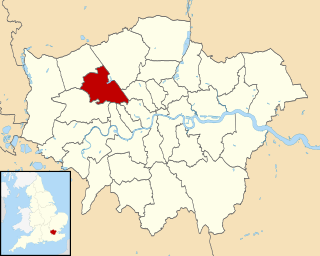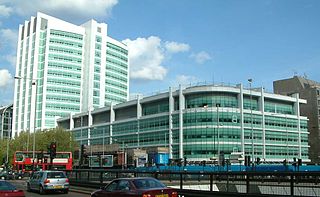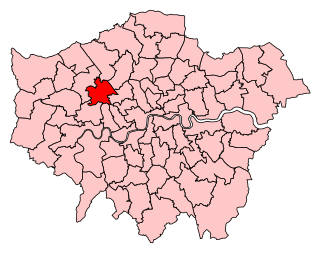Related Research Articles

The Bakerloo line is a London Underground line that runs from Harrow & Wealdstone in suburban north-west London to Elephant & Castle in south London, via the West End. Printed in brown on the Tube map, it serves 25 stations, 15 of which are underground, over 14.4 miles (23.2 km). It runs partly on the surface and partly through deep-level tube tunnels.

The Jubilee line is a London Underground line that runs between Stratford in east London and Stanmore in the suburban north-west, via the Docklands, South Bank and West End. Opened in 1979, it is the newest line on the Underground network, although some sections of track date back to 1932 and some stations to 1879.

Neasden is a suburban area in northwest London, England. It is located around the centre of the London Borough of Brent and is within the NW2 (Cricklewood) and NW10 (Willesden) postal districts. Neasden is near Wembley Stadium, the Welsh Harp, and Gladstone Park; the reservoir and River Brent marks its boundaries with Kingsbury and Wembley, while Gladstone Park and the Dudding Hill line separates it from Dollis Hill and Church End respectively. The A406 North Circular Road runs through the middle of Neasden; to the west is the Neasden Underground Depot, Brent Park retail area and the St Raphael's Estate; on the east is Neasden tube station, the large Neasden Temple, and former Neasden Power Station. The area is known as the place where Bob Marley lived after moving from Jamaica, living at a house in The Circle; the house was honoured with a blue plaque in 2012.

The London Borough of Brent is a London borough in north-west London. It borders the boroughs of Harrow to the north-west, Barnet to the north-east, Camden to the east, the City of Westminster to the south-east, as well as the Royal Borough of Kensington and Chelsea, Hammersmith and Fulham and Ealing to the south. Most of the eastern border is formed by the Roman road Watling Street, which is now the modern A5.

Dollis Hill is a London Underground station at Dollis Hill near to Willesden and Gladstone Park of the London Borough of Brent. It is on the Jubilee line, between Neasden and Willesden Green stations and is in Travelcard Zone 3. Metropolitan line trains pass through the station without stopping here.

Neasden is a London Underground station in Neasden. It is on the Jubilee line, between Wembley Park and Dollis Hill stations. Metropolitan line trains pass through the station but do not stop, except on rare occasions. The Chiltern Main Line/London to Aylesbury Line runs to the west of the station.

Willesden Green is a London Underground station on Walm Lane in Willesden. It is served by the Jubilee line and is between Dollis Hill and Kilburn stations. Metropolitan line trains also pass through the station, but do not usually stop. The station is in both Travelcard Zone 2 and Zone 3.

University College Hospital (UCH) is a teaching hospital in the Fitzrovia area of the London Borough of Camden, England. The hospital, which was founded as the North London Hospital in 1834, is closely associated with University College London (UCL), whose main campus is situated next door. The hospital is part of the University College London Hospitals NHS Foundation Trust

Brent East was a parliamentary constituency in north west London; it was replaced by Brent Central for the 2010 general election. It returned one Member of Parliament (MP) to the House of Commons of the Parliament of the United Kingdom, elected by the first past the post system.

Willesden was a local government district in the county of Middlesex, England from 1874 to 1965. It formed part of the Metropolitan Police District and London postal district. Willesden was part of the built-up area of London and bordered the County of London to the east and south.

Brent Central is a constituency represented in the House of Commons of the UK Parliament. It is currently represented, since 2015, by Dawn Butler of the Labour Party.

Croydon University Hospital, known from 1923 to 2002 as Mayday Hospital and from 2002 to 2010 as Croydon Hospital, is a large NHS hospital in Thornton Heath in south London, England run by Croydon Health Services NHS Trust. It is a District General Hospital with a 24-hour Accident and Emergency department. The hospital is based on a 19-acre (7.7 ha) site in Thornton Heath to the north of central Croydon.

Central Middlesex Hospital is in the centre of the Park Royal business estate, on the border of two London boroughs, Brent and Ealing. It is managed by the London North West University Healthcare NHS Trust.

The Dudding Hill Line is a railway line in west and north-west London running from Acton to Cricklewood. It is roughly 4 miles (6.4 km) long, with a 30 miles per hour (48 km/h) speed limit, and semaphore signalling. The line has no scheduled passenger service, no stations, and is not electrified. It is lightly used by freight trains and, very occasionally, passenger charter trains.

Dollis Hill House was an early 19th-century house also known as Dollis Hill Villa in today's north London suburb of Dollis Hill. Most of its gardens, south, form Gladstone Park and its owners were the freeholders of the farm estate, north, Dollis Hill Farm which together occupied the eminence, known as Dollis Hill, along with part of Willesden Paddocks in the parish of that name. Guests such as William Ewart Gladstone and Mark Twain were entertained there. The house became derelict after successive fire damage in 1995, 1996 and 2011, the last of which being the basement. As such the building was demolished in 2012 but a performance centre sits on its footprint. Dollis Hill House was an initial-class listed building and reached grade A on the English Heritage Buildings at Risk Register.

Willesden railway station was a station about 50 yards (46 m) north of Acton Lane level crossing in Harlesden, Middlesex, opened in 1841 by the London and Birmingham Railway (L&BR) on what became the West Coast Main Line (WCML). It had wooden platforms about 50 yards (46 m) long beside each of the two tracks, a small wooden ticket office with an awning and a coal siding. It was about 3⁄4 mile (1.2 km) south of the original village of Willesden, in what is now the London Borough of Brent. It closed later the same year, reopened in 1844 and closed finally when the L&BR's successor, the London and North Western Railway (LNWR), opened Willesden Junction station about 1⁄2 mile (0.8 km) to the southeast on 1 September 1866. On 15 June 1912 the LNWR opened a new station, known as Harlesden, near the site.

Dudding Hill railway station was a station in Neasden, London NW2 on the Dudding Hill Line.
Acton Lane Power Station was a power station in London NW10. The station, also known as Willesden power station, was located to the south of the Euston to Birmingham railway on a site bounded by Acton Lane, the Grand Union Canal and the Dudding Hill railway line. In later years the site was extended to the south side of the canal. The entire site is now occupied by Willesden Grid Supply Point buildings.

Neasden Depot is a London Underground depot located in Neasden in the London Borough of Brent, between Neasden and Wembley Park stations on the Metropolitan line. It is the largest depot on the London Underground, and is currently responsible for maintenance and overhaul of the 191 S Stock trains used on the Circle, District, Hammersmith & City and Metropolitan lines.

Gladstone Park is situated in the Dollis Hill area of north-west London. It is about 35 hectares in area.
References
- 1 2 3 "Neasden Hospital". Lost Hospitals of London. Retrieved 13 April 2014.
- ↑ "The South London Women's Hospital Occupation 1984-85". Past tense. Retrieved 7 April 2014.